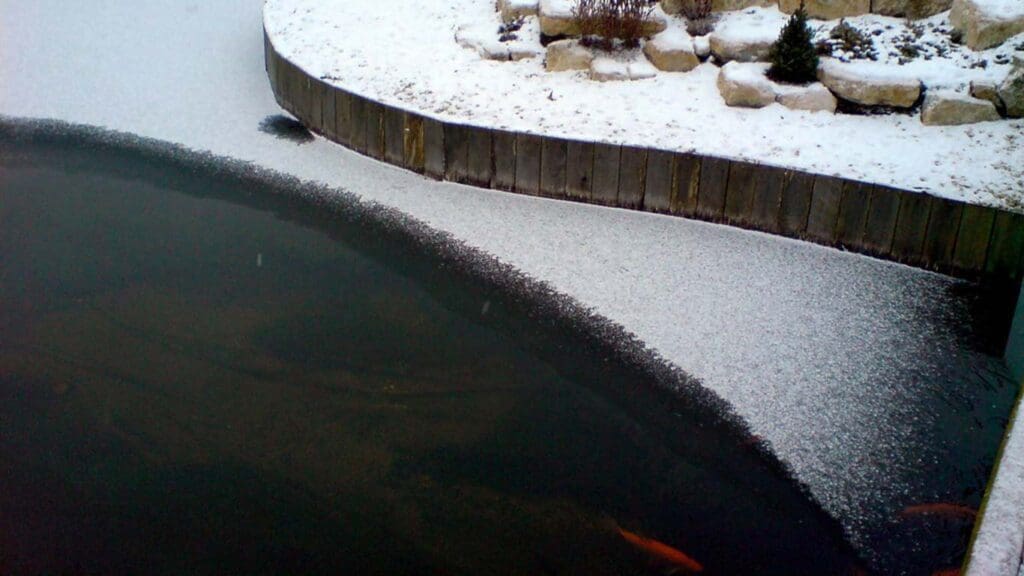Winter can be a challenging time for koi pond owners. The cold weather and freezing temperatures can cause harm to your fish and the pond’s ecosystem. To ensure that your koi remain healthy and your pond is in good condition throughout the winter, it’s important to winterize your pond properly.
Winterizing a koi pond involves taking several steps to protect your fish, plants, and pond equipment from the harsh winter weather. This includes adjusting your fish’s diet, installing a pond heater, adding an air pump, and maintaining water quality. By following these steps, you can ensure that your koi pond remains healthy and vibrant throughout the winter months.
How to Winterize a Koi Pond- Core Insights:
Understanding Koi Pond Winterization
Winter can be a challenging time for koi pond owners. As the temperature drops, it is essential to take steps to ensure that your fish are safe and healthy throughout the season. Winterization is the process of preparing your pond for the colder months, and it involves several steps to ensure that your koi can survive and thrive.
One of the most critical steps in winterization is to keep your pond from freezing over completely. When water freezes, it expands, which can damage your pond and harm your fish. To prevent this from happening, you should keep a hole open in the ice. This can be done by using an air pump or a pond heater. By keeping the water moving, you can prevent it from freezing solid.
Another essential aspect of winterization is adjusting your koi’s feeding schedule. As the temperature drops, your fish’s metabolism slows down, and they become less active. This means that they need less food, and overfeeding can lead to health problems. You should gradually reduce the amount of food you give your koi as the temperature drops. Once the water temperature falls below 50°F, you should stop feeding your fish altogether.
Moreover to adjusting your koi’s feeding schedule, you should also take steps to keep your pond clean. This means removing any debris or dead leaves that may accumulate in your pond. Decomposing organic matter can release harmful chemicals into the water, which can be harmful to your fish. You should also consider using healthy bacteria to keep your pond clean and balanced.
Overall, winterizing your koi pond is essential for ensuring the health and well-being of your fish. By taking the necessary steps to prepare your pond for the colder months, you can help your koi survive and thrive throughout the winter season.
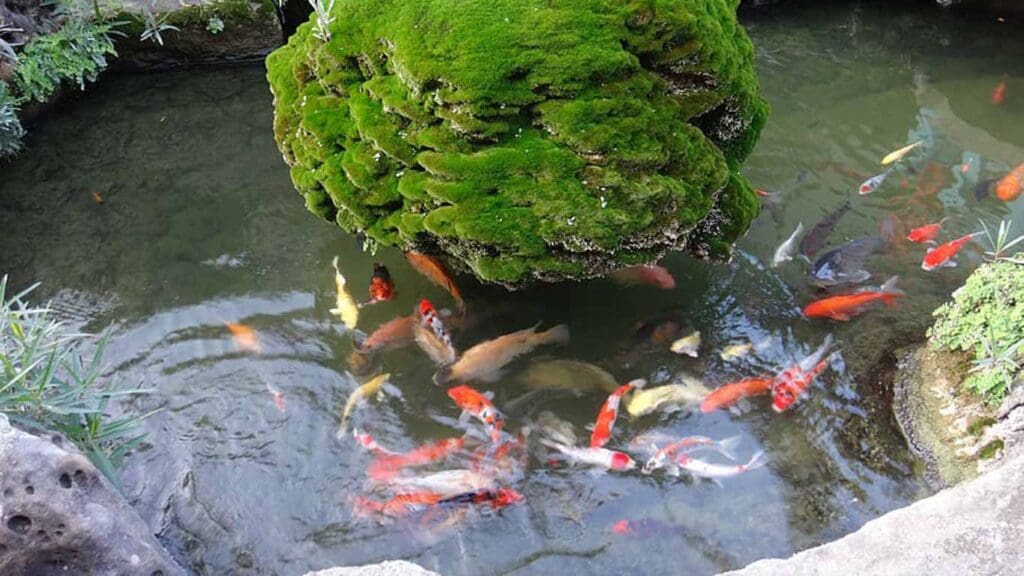

Importance of Winterizing Your Koi Pond
Winterizing your koi pond is crucial to ensure the health and survival of your fish during the cold winter months. Without proper winterization, your koi may suffer from stress, illness, and even death. Here are some reasons why winterizing your koi pond is important:
Prevents Freezing
During winter, the water in your koi pond can freeze, which can be harmful to your fish. The ice can trap gases, such as ammonia, which can lead to toxic levels in the water. Also, the ice can prevent oxygen from entering the water, which can suffocate your fish. By winterizing your koi pond, you can prevent freezing and ensure that your fish have access to oxygen and a healthy environment.
Maintains Water Quality
Winterizing your koi pond can help maintain water quality. As the temperature drops, the metabolism of your fish slows down, which means they produce less waste. By reducing the amount of waste in the water, you can prevent the buildup of harmful toxins and bacteria that can harm your fish. Additionally, winterizing your koi pond can help maintain a stable pH level, which is essential for the health of your fish.


Get Advice from a Koi Pond Expert – Join our KPE Community!
Prepares Your Fish for Hibernation
Koi are cold-blooded animals, which means their metabolism and activity levels are affected by the temperature of the water. As the temperature drops, your koi will become less active and enter a state of hibernation. By winterizing your koi pond, you can prepare your fish for this natural process and ensure that they have a safe and comfortable environment to hibernate in.
In brief, winterizing your koi pond is crucial for the health and survival of your fish during the cold winter months. It can prevent freezing, maintain water quality, and prepare your fish for hibernation. By following the proper steps to winterize your koi pond, you can ensure that your fish stay healthy and happy throughout the winter season.
Checking the Pond’s Health
Before winterizing your koi pond, it’s important to check the health of the pond and its inhabitants. Here are some steps you can take to ensure that your pond is in good condition before winter sets in:
- Check the water quality: Test the water to make sure it’s within the appropriate range for koi. The ideal pH range for koi is between 7.0 and 8.0. Ammonia and nitrite levels should also be monitored as they can be harmful to fish. If the levels are too high, consider doing a partial water change.
- Check for parasites and diseases: Look for any signs of illness or parasites in your koi. Common symptoms include lethargy, loss of appetite, and abnormal behavior. If you notice any of these symptoms, consult a veterinarian or a koi specialist for advice.
- Check the pond equipment: Make sure that all the equipment in your pond is functioning properly. Check the filters, pumps, and heaters to ensure that they are working efficiently. Clean or replace any equipment that is not functioning properly.
- Check the pond plants: Remove any dead or dying plants from the pond. This will help prevent the buildup of organic matter in the pond, which can lead to poor water quality.
By taking these steps, you can ensure that your pond is in good condition before winter arrives. This will help your koi survive the winter months and emerge healthy and strong in the spring.
Adjusting the Fish Diet
As the water temperature decreases, the metabolism of your koi slows down. They become less active and will need less food. It is important to adjust their feeding schedule accordingly to prevent overfeeding, which can lead to health problems.
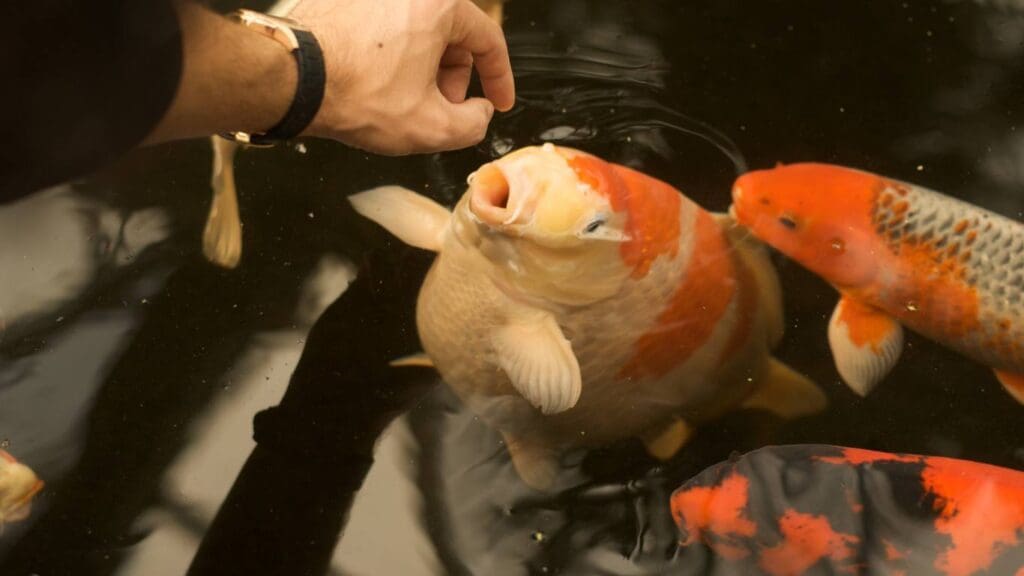

Here are some tips for adjusting your koi’s diet during the winter:
- Monitor water temperature: Use a thermometer to monitor the water temperature regularly. When the water temperature drops below 50°F, you should reduce the amount of food you feed your koi.
- Feed less frequently: Instead of feeding your koi multiple times a day, reduce the frequency to once a day or every other day. This will prevent overfeeding and reduce waste in the pond.
- Use a high-quality food: During the winter, it is important to feed your koi a high-quality food that is easily digestible. Look for a food that is specifically designed for winter feeding and contains ingredients that promote healthy digestion and immune function.
- Consider adding supplements: You may want to consider adding supplements to your koi’s diet during the winter. These can include probiotics, vitamin C, and garlic, which can help boost their immune system and improve digestion.
By adjusting your koi’s diet during the winter, you can help ensure they stay healthy and happy throughout the season. Remember to monitor their behavior and health regularly to catch any potential issues early on.
Installing a Pond Heater
If you live in an area with cold winters, installing a pond heater is an essential step in winterizing your koi pond. A pond heater can help maintain a stable water temperature, preventing your pond from freezing over and keeping your koi fish healthy throughout the winter. In this section, we’ll cover the basics of installing a pond heater, including choosing the right heater and proper installation techniques.
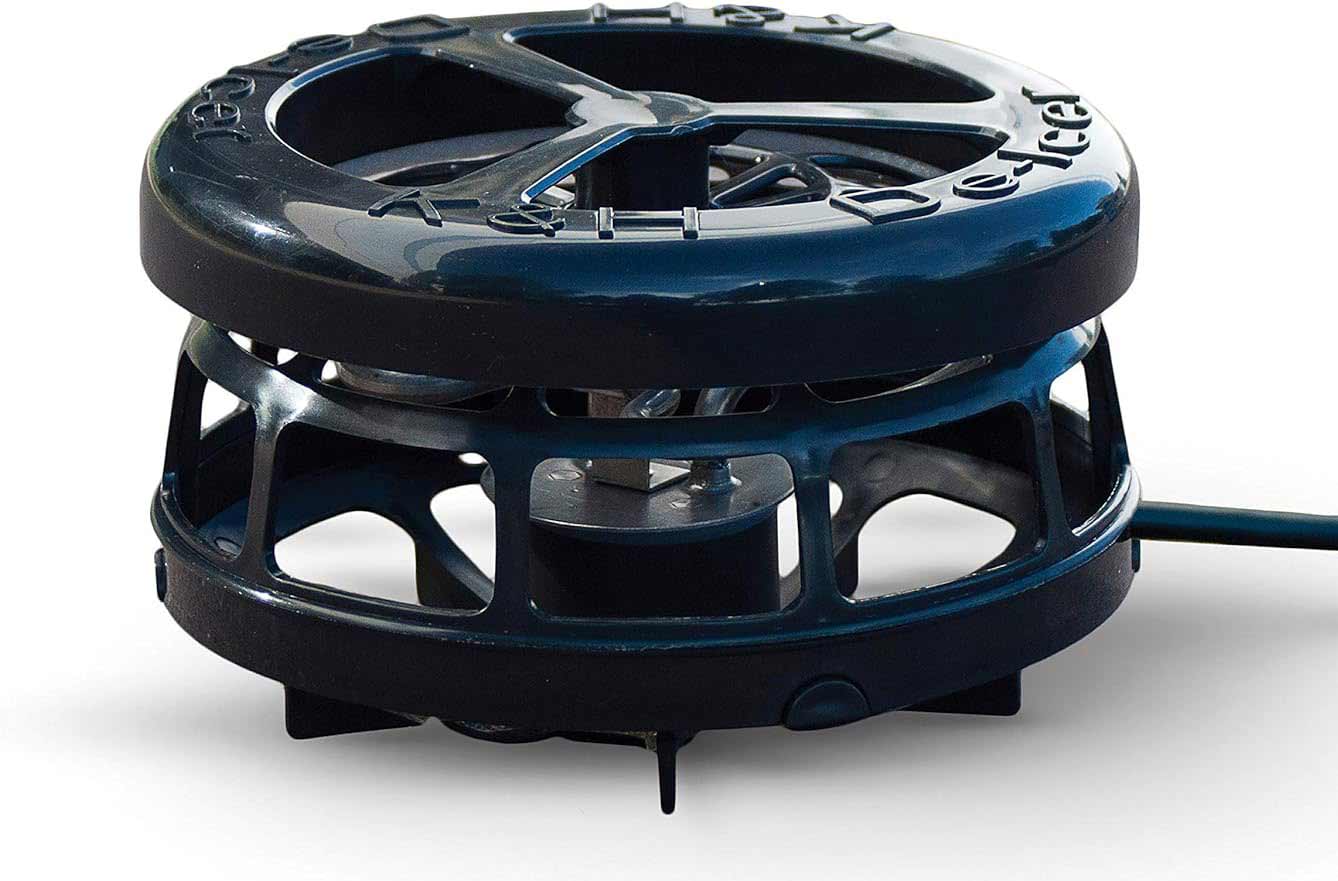

Thermo-Pond Perfect Climate Deluxe Pond Heater
Choosing the Right Heater
When selecting a pond heater, there are a few factors to consider. Here are some of the most important:
- Size of Your Pond: The size of your pond will determine the size of the heater you need. A good rule of thumb is to choose a heater that can heat your pond’s volume by at least 5-10 degrees Fahrenheit.
- Wattage: The wattage of your heater will affect its heating power and energy consumption. Higher wattage heaters will heat your pond faster but will also use more energy. Be sure to choose a heater with the appropriate wattage for your pond size.
- Type of Heater: There are several types of pond heaters available, including floating de-icers, submersible heaters, and in-line heaters. Each type has its own advantages and disadvantages, so be sure to research each option before making a decision.
Proper Heater Installation
Once you’ve selected the right heater for your pond, it’s time to install it properly. Here are some tips to ensure a successful installation:
- Choose the Right Location: Your heater should be placed in an area of your pond where it can circulate water effectively. Avoid placing it near the edge of the pond or in shallow areas where it may be disturbed by wind or other factors.
- Follow Manufacturer Instructions: Be sure to follow the manufacturer’s instructions carefully when installing your heater. This will ensure that it is installed correctly and will operate safely and efficiently.
- Use a GFCI Outlet: Your pond heater should be plugged into a ground fault circuit interrupter (GFCI) outlet to prevent electrical shocks and other hazards.
- Monitor Your Pond: Once your heater is installed, be sure to monitor your pond regularly to ensure that it is maintaining a stable temperature. Adjust the heater as necessary to achieve the desired temperature.
By following these tips, you can ensure that your pond heater is installed correctly and will provide your koi fish with the warmth they need to survive the winter.
Adding an Air Pump
If you want to ensure the survival of your koi fish during winter, adding an air pump to your pond is a must. An air pump helps to oxygenate the water and keep it circulating, preventing it from freezing over and trapping harmful gases that can harm your fish.
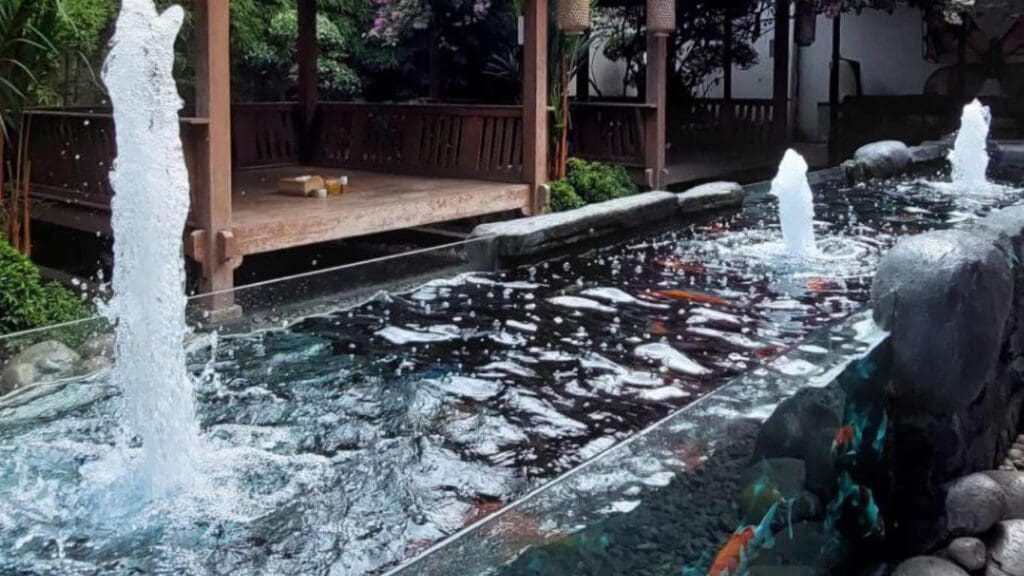

Types of Air Pumps
There are two main types of air pumps that you can use for your koi pond: diaphragm and piston pumps. Diaphragm pumps are more affordable and energy-efficient, but they have a shorter lifespan and are not as powerful as piston pumps. On the other hand, piston pumps are more expensive and consume more energy, but they can provide a higher volume of air and last longer.
Setting Up the Air Pump
Setting up an air pump for your koi pond is a straightforward process that you can easily do yourself. Here are the steps:
- Choose the right location for your air pump. It should be placed in a dry, sheltered area, away from direct sunlight and rain.
- Install the air pump on a solid surface, such as a concrete block or a wooden board, to prevent it from vibrating and moving around.
- Connect the air pump to the airline tubing and airstones. The airline tubing should be long enough to reach the bottom of your pond.
- Place the airstones at the bottom of your pond, evenly spaced out. You can use one large airstone or several smaller ones, depending on the size of your pond.
- Turn on the air pump and check the airflow. You should see bubbles rising from the airstones and circulating the water.
- Adjust the airflow if necessary. If the bubbles are too small or too few, you can increase the airflow by adjusting the air valve. If the bubbles are too large or too many, you can decrease the airflow by adding a flow control valve.
By following these simple steps, you can ensure that your koi fish will have enough oxygen and a healthy environment to survive the winter.
Pond Air Pump for Koi Pond up to 1000 Gallons
$46.99 in stock
Maintaining Water Quality
One of the most important aspects of winterizing your koi pond is maintaining water quality. During the winter months, your pond can become a breeding ground for harmful bacteria and algae, which can cause health problems for your koi. Here are some tips to help you maintain water quality during the winter months.
Checking Water Parameters
Before winter sets in, it’s important to check the water parameters in your koi pond. This includes pH, ammonia, nitrite, and nitrate levels. You can use a test kit to check these levels, or you can take a sample of water to your local pet store for testing.
If you find that the water parameters are off, you will need to take steps to correct them. For example, if the pH is too high or too low, you can add a pH buffer to bring it back to a healthy level. If the ammonia, nitrite, or nitrate levels are too high, you can add a biological filter to help remove these toxins from the water.
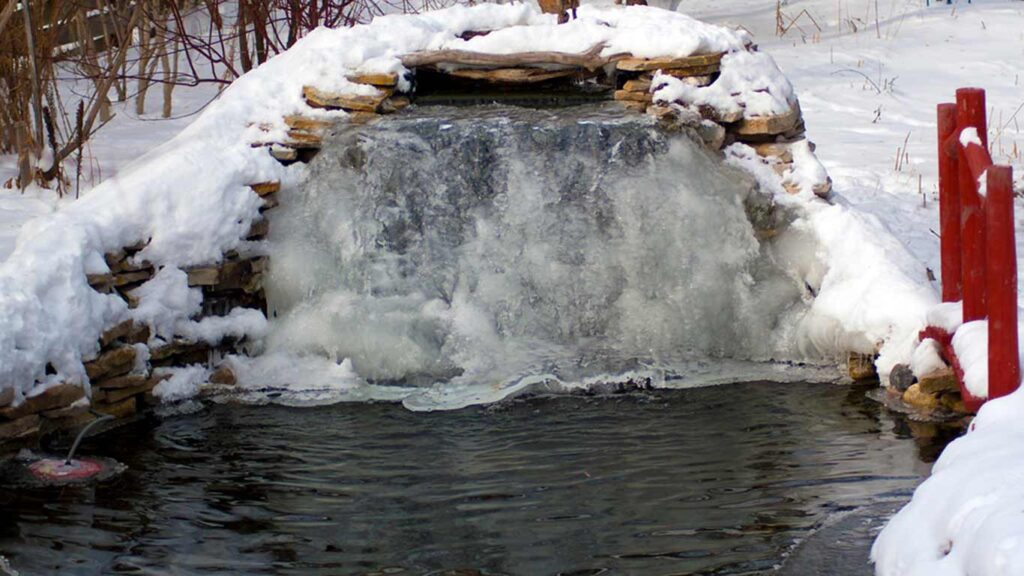

Using a De-Icer
During the winter months, your koi pond may freeze over. This can be dangerous for your koi, as it can trap harmful gases under the ice. To prevent this from happening, you can use a de-icer to keep a hole open in the ice.
A de-icer is a device that floats on the surface of the water and uses electricity to keep a small area of the pond from freezing over. This allows harmful gases to escape and oxygen to enter the water, which is essential for the health of your koi.
When using a de-icer, it’s important to follow the manufacturer’s instructions carefully. Make sure the device is properly grounded and that the electrical cord is not damaged. You should also monitor the de-icer regularly to ensure it is working properly.
By checking water parameters and using a de-icer, you can help maintain water quality in your koi pond during the winter months. This will help ensure the health and well-being of your koi, and will make it easier to transition your pond back to normal in the spring.
Protecting the Pond from Predators
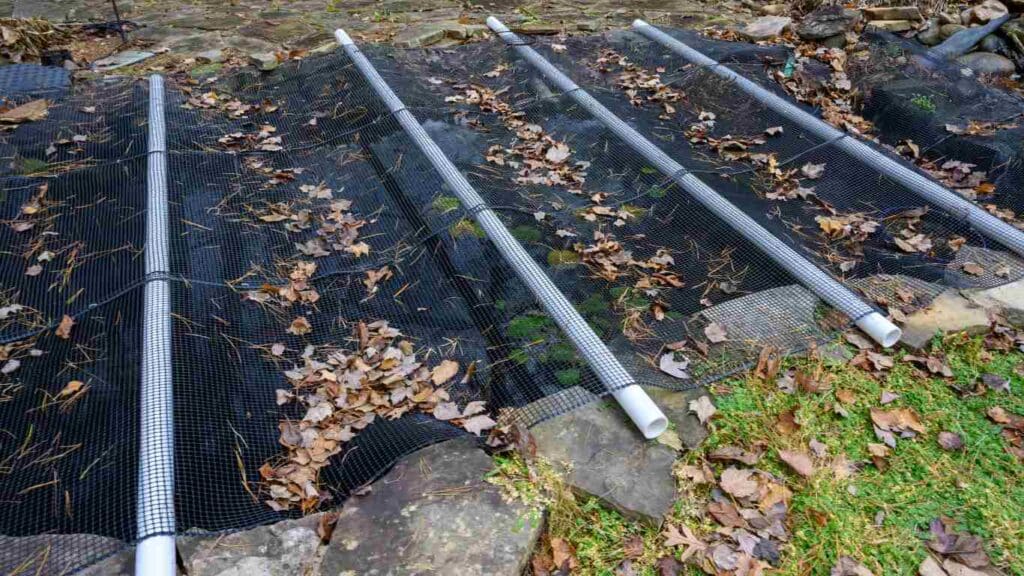

Predators can be a big problem for your koi pond. Herons, raccoons, and other animals can cause damage to your pond and harm your koi. Here are some tips to prevent predators from getting to your koi:
- Cover your pond: A strong cover can protect your pond from cold winds, snow, and even predators. You can either purchase a pond cover or create your own using netting or wire mesh.
- Install motion-activated lights: Predators are less likely to approach your pond if it’s well-lit. Install motion-activated lights around your pond to deter animals from getting too close.
- Use decoys: Decoys like fake alligators or herons can scare off real predators. Place them around your pond to make predators think twice about approaching.
- Add hiding spots: Adding hiding spots like rocks, plants, and caves can give your koi a place to hide if a predator does get into your pond.
- Keep your pond clean: A clean pond is less attractive to predators. Make sure to remove any dead leaves or debris from your pond regularly.
By taking these steps, you can help protect your koi and keep predators away from your pond.
Preparing the Pond Plants
When winterizing your koi pond, it’s important to prepare your pond plants for the colder months. Here are some steps to follow:
- Remove floating tropical plants: Before the first frost, remove any tropical plants that are floating on the surface of the water. These plants are not hardy enough to survive the winter.
- Cut back perennial hardy plants: Cut back any hardy plants that are perennials to just above the water level. This will help prevent the plants from dying back too far during the winter.
- Clean leaves and debris: Remove any leaves or debris from the pond plants. This will help prevent the buildup of organic matter that can lead to toxic gases in the water.
- Place a net over your pond: Cover your pond with a net to prevent leaves and debris from falling into the water. This will also help keep predators away from your fish.
- Ensure the water is aerated: If you have a pond aerator, make sure it’s running during the winter months. This will help keep the water oxygenated and prevent it from becoming stagnant.
- Use a de-icer: Place a de-icer in your pond to prevent the water surface from freezing over completely. This will allow gases to escape from the water and prevent toxic buildup.
By following these steps, you can help ensure that your pond plants survive the winter and come back healthy in the spring.


Get the Information You Need Direct from Koi Pond Experts
Join Now!
Post-Winter Care
Now that winter is over, it’s time to prepare your koi pond for spring. Proper post-winter care is essential to ensure the health of your koi and the longevity of your pond. Here are a few things you should do to get your pond ready for the warmer months ahead:
- Remove debris: Remove any leaves, twigs, or other debris that may have accumulated in your pond over the winter. This will help improve water quality and prevent the growth of harmful bacteria.
- Test water quality: Test your pond water to ensure that the pH, ammonia, nitrite, and nitrate levels are within the appropriate range. If any of these levels are too high, take steps to correct them before adding fish to your pond.
- Add beneficial bacteria: Add beneficial bacteria to your pond to help jumpstart the nitrogen cycle and break down any organic waste that may have accumulated over the winter.
- Check equipment: Check all of your pond equipment, including pumps, filters, and UV clarifiers, to ensure that they are functioning properly. Replace any damaged or worn-out parts as needed.
- Add plants: Add aquatic plants to your pond to help absorb excess nutrients and improve water quality. Choose plants that are appropriate for your climate and water conditions.
- Slowly reintroduce fish: Slowly reintroduce your koi to your pond, giving them time to acclimate to the new water conditions. Start by adding a few fish at a time, and monitor their behavior and health closely.
By following these post-winter care tips, you can help ensure the health and well-being of your koi and your pond. Remember to monitor your pond regularly and address any issues promptly to prevent them from becoming bigger problems down the road.
Frequently Asked Questions
What is the best way to winterize a koi pond?
The best way to winterize a koi pond is to prepare it for the colder months by cleaning it thoroughly, removing any debris, and reducing the amount of food you give your koi. You should also consider installing a pond heater to keep the water temperature stable and prevent it from freezing over.
How deep should a koi pond be for winter?
A koi pond should be at least 3 feet deep to ensure that the water does not freeze over completely during the winter months. This will also help to maintain a stable water temperature and prevent any damage to your koi.
What is a pond heater and how does it help winterize a koi pond?
A pond heater is a device that is designed to keep the water temperature stable in your koi pond during the winter months. It works by heating the water, which prevents it from freezing over and causing damage to your koi. A pond heater is an essential tool for winterizing your koi pond.
How do you winterize an outdoor koi pond?
To winterize an outdoor koi pond, you should start by cleaning it thoroughly and removing any debris. You should also reduce the amount of food you give your koi and consider installing a pond heater to keep the water temperature stable. Additionally, you should consider covering the pond with a net to prevent leaves and other debris from falling into the water.
How cold can koi survive in a winterized pond?
Koi can survive in a winterized pond as long as the water temperature does not drop below 40°F. However, it is important to ensure that the water temperature remains stable and does not fluctuate too much during the winter months.
When should you start winterizing your koi pond?
You should start winterizing your koi pond in the fall, before the temperatures start to drop. This will give you enough time to clean the pond, install a pond heater, and prepare your koi for the colder months. Starting early will also help to prevent any damage to your koi and ensure that they remain healthy throughout the winter.
 1 (509) 228-8646
1 (509) 228-8646


